Use of Electronic UV Dosimeters in Measuring Personal UV Exposures and Public Health Education
Abstract
1. Introduction
2. Electronic UV Dosimeter Details
2.1. Design and Operation
2.2. Key UVR Sensing Components
2.2.1. AlGaN Schottky Photodiodes
2.2.2. PTFE Diffuser
3. Results
3.1. Spectral Mismatch Errors, Cosine Response Errors, and the Use of Correction Factors
3.1.1. Spectral Mismatch Errors
3.1.2. Cosine Response Errors
3.1.3. Conversion to Vitamin D-Weighted UV Irradiances
3.2. Cross-Calibration of EUV Dosimeters
3.2.1. Examples of EUV Dosimeter Cross-Calibrations
3.2.2. EUV Dosimeter Stability
3.3. Effect of EUV Dosimeter Sampling Frequency
4. Discussion
5. Conclusions
Supplementary Materials
Author Contributions
Funding
Acknowledgments
Conflicts of Interest
Appendix A. Dosimeter #2
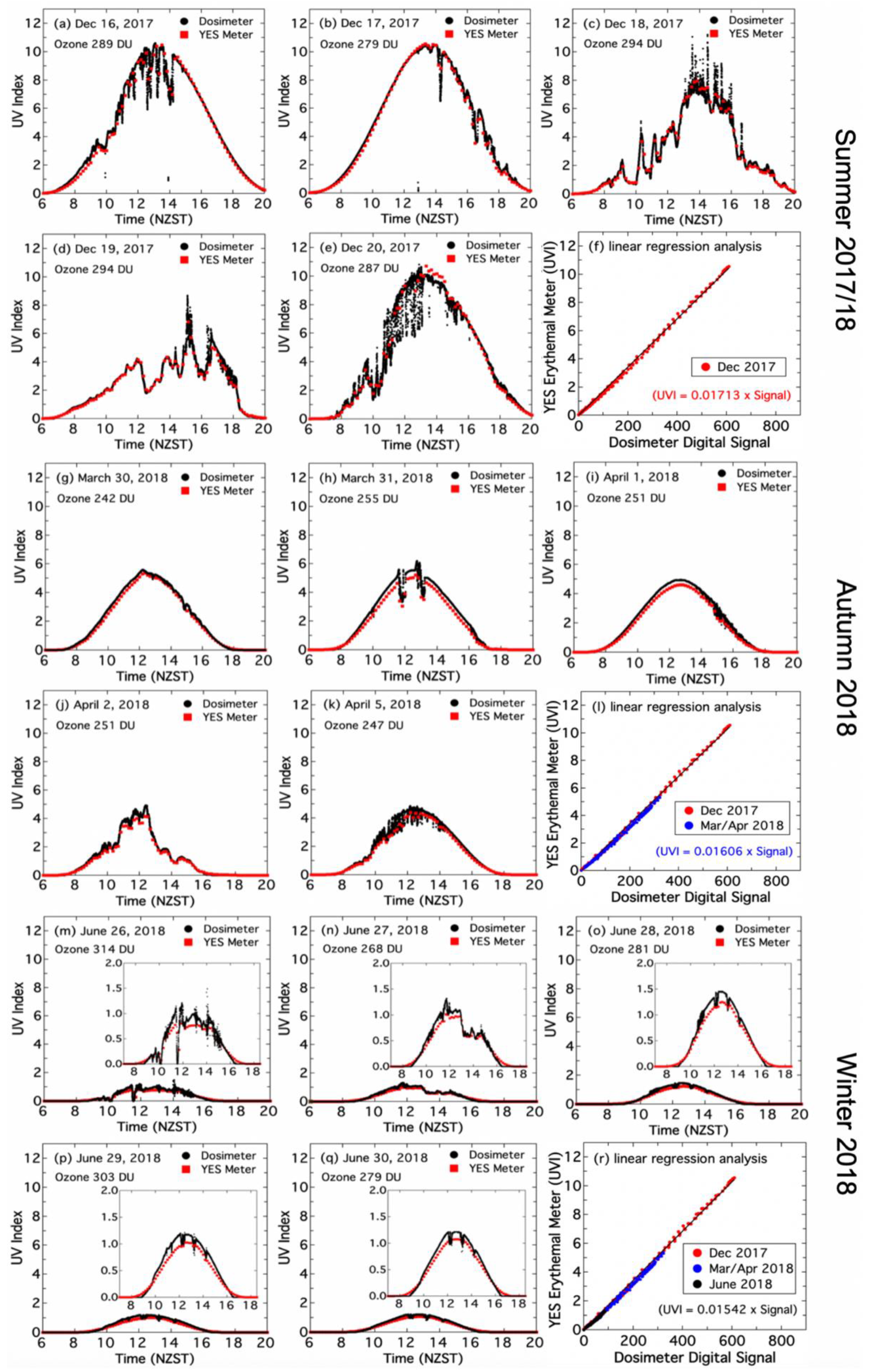
Appendix B. Dosimeter #3

Appendix C. Dosimeter #4
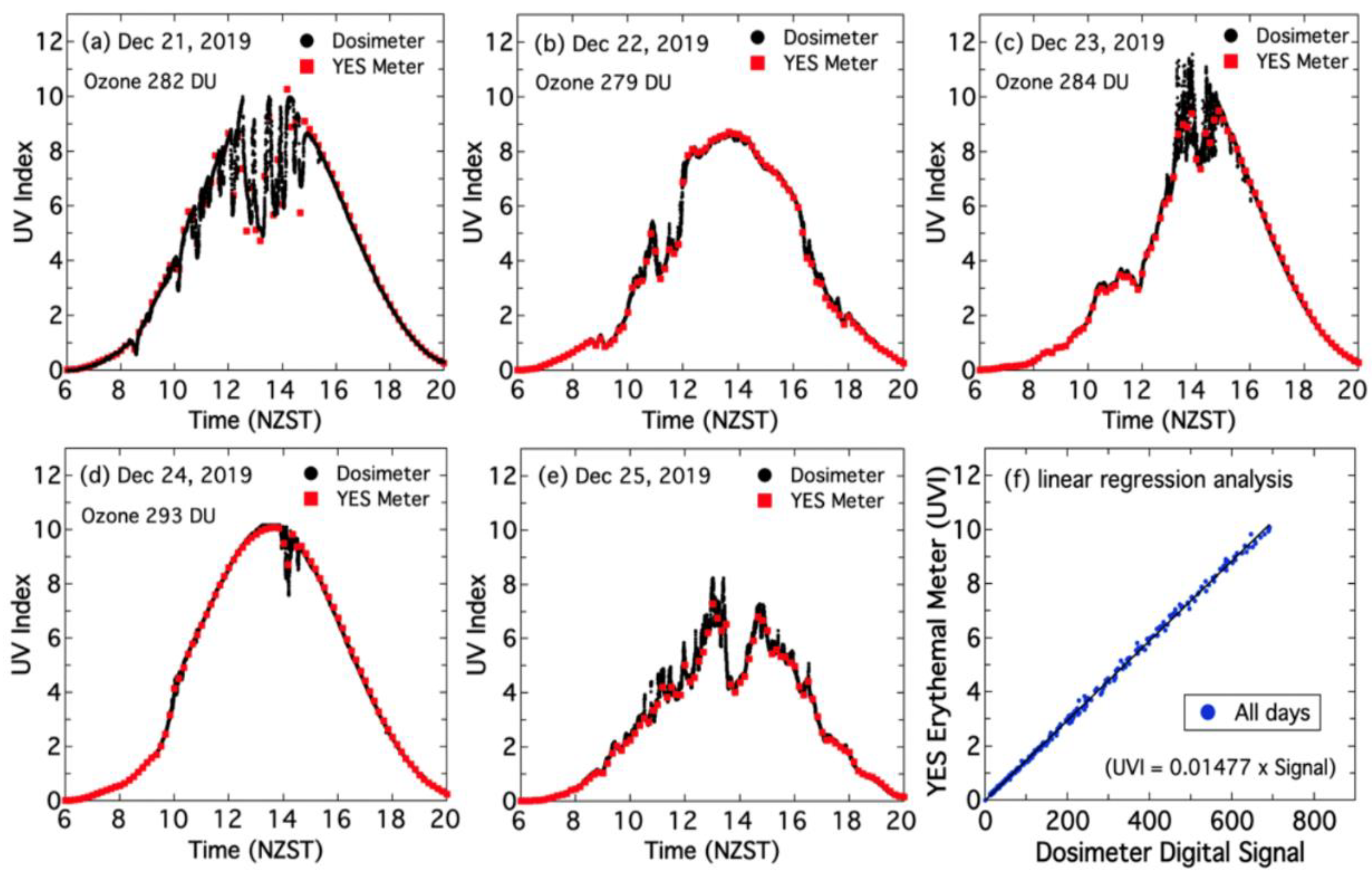
Appendix D. Dosimeter #5

Appendix E. Dosimeter #6
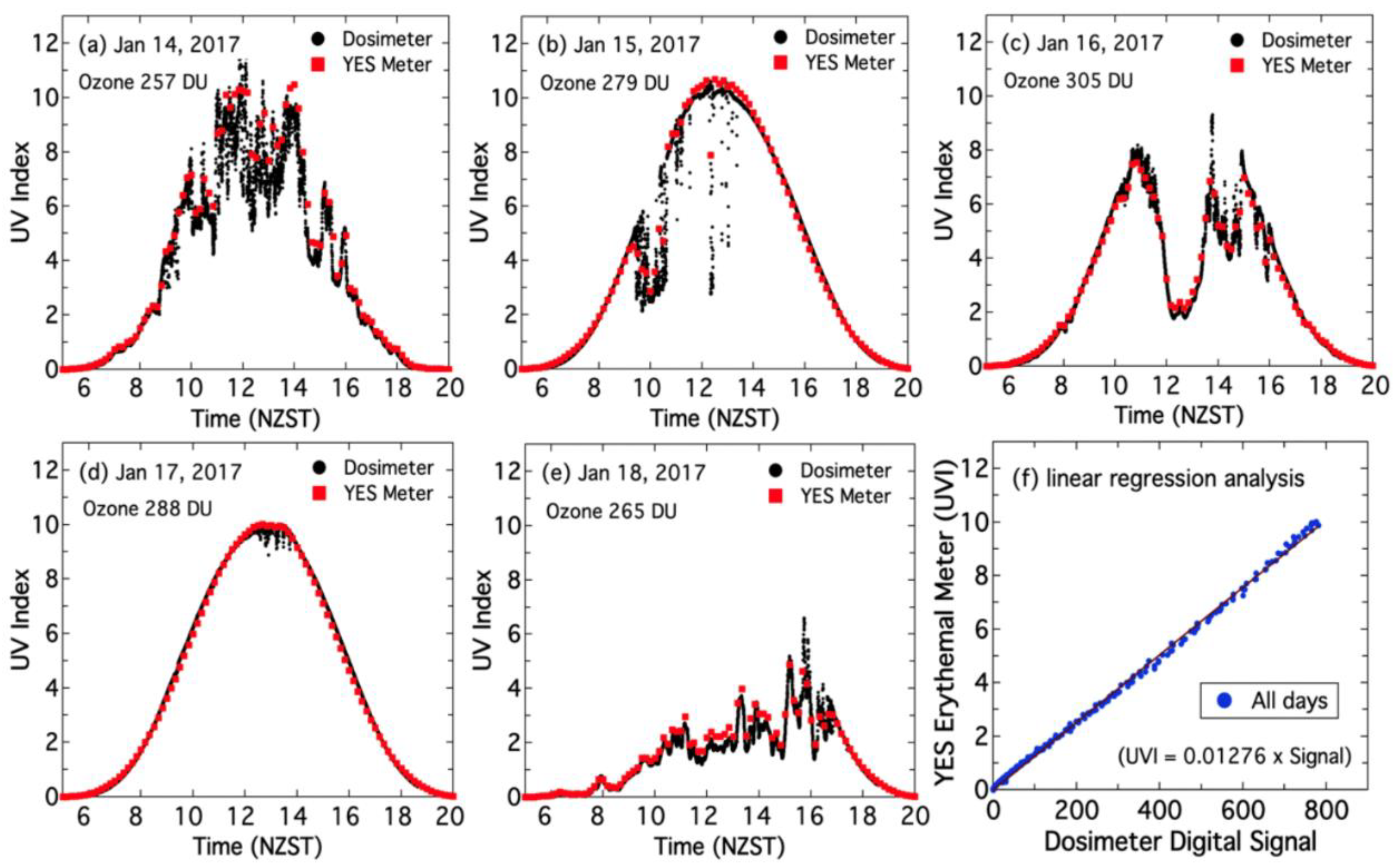
Appendix F. Calibration Using 10 min Rolling Averages of the Dosimeter Signal
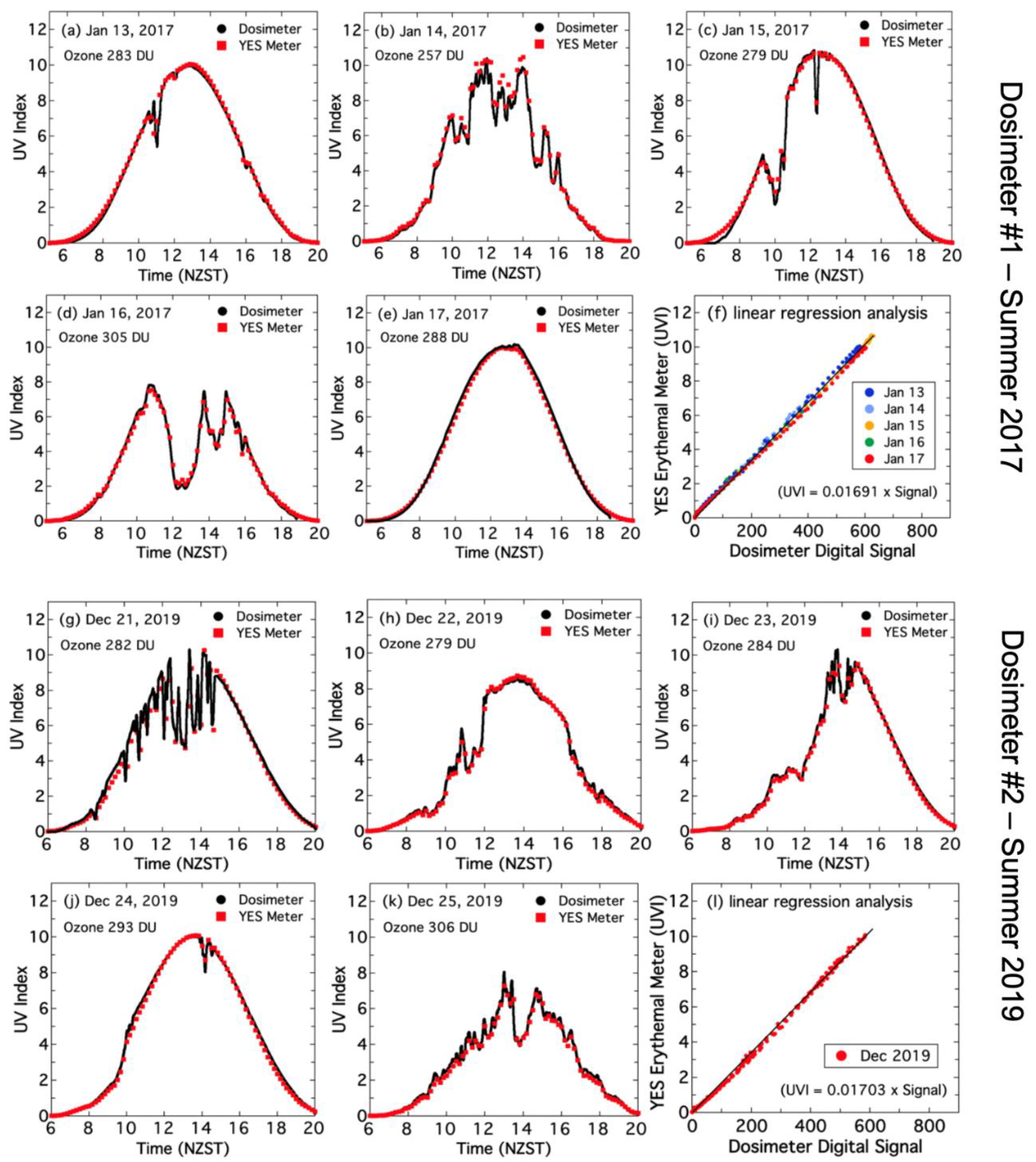
References
- Karimkhani, C.; Green, A.C.; Nijsten, T.; Weinstock, M.A.; Dellavalle, R.P.; Naghavi, M.; Fitzmaurice, C. The global burden of melanoma: Results from the Global Burden of Disease Study 2015. Br. J. Dermatol. 2017, 177, 134–140. [Google Scholar] [CrossRef] [PubMed]
- Bray, F.; Ferlay, J.; Soerjomataram, I.; Siegel, R.L.; Torre, L.A.; Jemal, A. Global cancer statistics 2018: GLOBOCAN estimates of incidence and mortality worldwide for 36 cancers in 185 countries. CA Cancer J. Clin. 2018, 68, 394–424. [Google Scholar] [CrossRef] [PubMed]
- Holick, M.F. High Prevalence of Vitamin D Inadequacy and Implications for Health. Mayo Clin. Proc. 2006, 81, 353–373. [Google Scholar] [CrossRef] [PubMed]
- Chowdhury, R.; Kunutsor, S.; Vitezova, A.; Oliver-Williams, C.; Chowdhury, S.; Kiefte-De-Jong, J.C.; Khan, H.; Baena, C.P.; Prabhakaran, D.; Hoshen, M.B.; et al. Vitamin D and risk of cause specific death: Systematic review and meta-analysis of observational cohort and randomised intervention studies. BMJ 2014, 348, 1903. [Google Scholar] [CrossRef] [PubMed]
- Bjelakovic, G.; Gluud, L.L.; Nikolova, D.; Whitfield, K.; Wetterslev, J.; Simonetti, R.G.; Bjelakovic, M.; Gluud, C. Vitamin D supplementation for prevention of mortality in adults (Review) Bjelakovic. Cochrane Database Syst. Rev. 2014. [Google Scholar] [CrossRef]
- Holick, M.F. Sunlight and vitamin D for bone health and prevention of autoimmune diseases, cancers, and cardiovascular disease. Am. J. Clin. Nutr. 2004, 80, 1678S–1688S. [Google Scholar] [CrossRef]
- Holick, M.F. The Vitamin D Epidemic and its Health Consequences. J. Nutr. 2005, 135, 2739S–2748S. [Google Scholar] [CrossRef]
- Lucas, R.M.; Yazar, S.; Young, A.R.; Norval, M.; De Gruijl, F.R.; Takizawa, Y.; Rhodes, L.E.; Sinclair, C.A.; Neale, R.E. Human health in relation to exposure to solar ultraviolet radiation under changing stratospheric ozone and climate. Photochem. Photobiol. Sci. 2019, 18, 641–680. [Google Scholar] [CrossRef]
- Holick, M.F. Sunlight, ultraviolet radiation, vitamin d and skin cancer: How much sunlight do we need? Adv. Exp. Med. Biol. 2014, 810, 1. [Google Scholar]
- McKenzie, R.L.; Liley, J.B.; Björn, L.O. UV radiation: Balancing risks and benefits. Photochem. Photobiol. 2009, 85, 88–98. [Google Scholar] [CrossRef]
- McKenzie, R. UV radiation in the melanoma capital of the world: What makes New Zealand so different? AIP Conf. Proc. 2017, 1810, 020003. [Google Scholar]
- McKenzie, R.; Bodeker, G.; Scott, G.; Slusser, J.; Lantz, K. Geographical differences in erythemally-weighted UV measured at mid-latitude USDA sites. Photochem. Photobiol. Sci. 2006, 5, 343–352. [Google Scholar] [CrossRef] [PubMed]
- McKenzie, R.; Smale, D.; Bodeker, G.; Claude, H. Ozone profile differences between Europe and New Zealand: Effects on surface UV irradiance and its estimation from satellite sensors. J. Geophys. Res. D Atmos. 2003, 108, 4179. [Google Scholar] [CrossRef]
- Nessvi, S.; Johansson, L.; Jopson, J.; Stewart, A.; Scragg, R.K. Association of 25-Hydroxyvitamin D 3 Levels Ethnicity, Skin Color and Self-Reported Skin Association of Ethnicity, Skin Color and Self-Reported Skin. Photochem. Photobiol. 2011, 87, 1173–1178. [Google Scholar] [CrossRef]
- Diffey, B. The early days of personal solar ultraviolet dosimetry. Atmosphere 2020, 11, 125. [Google Scholar] [CrossRef]
- Siani, A.M.; Casale, G.R.; Modesti, S.; Parisi, A.V.; Colosimo, A. Investigation on the capability of polysulphone for measuring biologically effective solar UV exposures. Photochem. Photobiol. Sci. 2014, 13, 521–530. [Google Scholar] [CrossRef]
- Allen, M.; McKenzie, R. Enhanced UV exposure on a ski-field compared with exposures at sea level. Photochem. Photobiol. Sci. 2005, 4, 429–437. [Google Scholar] [CrossRef]
- Wright, C.Y.; Reeder, A.I.; Bodeker, G.E.; Gray, A.; Cox, B. Solar UVR Exposure, Concurrent Activities and Sun-Protective Practices Among Primary Schoolchildren. Photochem. Photobiol. 2007, 83, 749–758. [Google Scholar] [CrossRef]
- Hammond, V.; Reeder, A.I.; Gray, A. Patterns of real-time occupational ultraviolet radiation exposure among a sample of outdoor workers in New Zealand. Public Health 2009, 123, 182–187. [Google Scholar] [CrossRef]
- Scragg, R.K.R.; Stewart, A.W.; McKenzie, R.L.; Reeder, A.I.; Liley, J.B.; Allen, M.W. Sun exposure and 25-hydroxyvitamin D 3 levels in a community sample: Quantifying the association with electronic dosimeters. J. Expo. Sci. Environ. Epidemiol. 2017, 27, 471–477. [Google Scholar] [CrossRef]
- McKenzie, R.; Liley, B.; Johnston, P.; Scragg, R.; Stewart, A.; Reeder, A.I.; Allen, M.W. Small doses from artificial UV sources elucidate the photo-production of vitamin D. Photochem. Photobiol. Sci. 2013, 12, 1726–1737. [Google Scholar] [CrossRef]
- Seckmeyer, G.; Klingebiel, M.; Riechelmann, S.; Lohse, I.; McKenzie, R.L.; Ben Liley, J.; Allen, M.W.; Siani, A.M.; Casale, G.R. A critical assessment of two types of personal UV dosimeters. Photochem. Photobiol. 2012, 88, 215–222. [Google Scholar] [CrossRef] [PubMed]
- Hacker, E.; Horsham, C.; Allen, M.; Nathan, A.; Lowe, J.; Janda, M. Capturing ultraviolet radiation exposure and physical activity: Feasibility study and comparison between self-reports, mobile apps, dosimeters, and accelerometers. J. Med. Internet Res. 2018, 7, e102. [Google Scholar] [CrossRef] [PubMed]
- Swaminathan, A.; Harrison, S.L.; Ketheesan, N.; van den Boogaard, C.H.A.; Dear, K.; Allen, M.; Hart, P.H.; Cook, M.; Lucas, R.M. Exposure to Solar UVR Suppresses Cell-Mediated Immunization Responses in Humans: The Australian Ultraviolet Radiation and Immunity Study. J. Investig. Dermatol. 2019, 139, 1545–1553. [Google Scholar] [CrossRef] [PubMed]
- Smit, A.K.; Newson, A.J.; Morton, R.L.; Kimlin, M.; Keogh, L.; Law, M.H.; Kirk, J.; Dobbinson, S.; Kanetsky, P.A.; Fenton, G.; et al. The melanoma genomics managing your risk study: A protocol for a randomized controlled trial evaluating the impact of personal genomic risk information on skin cancer prevention behaviors. Contemp. Clin. Trials 2018, 70, 106–116. [Google Scholar] [CrossRef] [PubMed]
- Allen, M.W.; Miller, K.A.; Cockburn, M.G. SunSmart UV dosimetry programmes: From Southern Californian to New Zealand schools. In Proceedings of the NIWA UV Workshop, Auckland, New Zealand, 15–17 April 2014; Available online: https://niwa.co.nz/sites/niwa.co.nz/files/Allen_UV%20Workshop_2014.pdf (accessed on 20 May 2020).
- Allen, M.W.; Hyland, A.M.; Salkeld, A.J.; Miller, K.A.; Cockburn, M.G. Use of Electronic UV Dosimeters in New Zealand School-based Primary Skin Cancer Prevention Programmes. In Proceedings of the NIWA UV Workshop, Wellington, New Zealand, 4–6 April 2018; Available online: https://niwa.co.nz/sites/niwa.co.nz/files/Allen_Use%20of%20Personal%20Dosimaters%20in%20School%20Sunsmart%20Programmes.pdf (accessed on 20 May 2020).
- Chow, P.P.; Klaassen, J.J.; Van Hove, J.M.; Wowchak, A.M.; Polley, C.; King, D. Group III-nitride materials for ultraviolet detection applications. In Proceedings of the Symposium on Integrated Optoelectronics, San Jose, CA, USA, 20–26 January 2000; Volume 3948, pp. 295–303. [Google Scholar]
- Monroy, E.; Calle, F.; Pau, J.L.; Muñoz, E.; Omnès, F.; Beaumont, B.; Gibart, P. AlGaN-based UV photodetectors. J. Cryst. Growth 2001, 230, 537–543. [Google Scholar] [CrossRef]
- Monroy, E.; Omnès, F.; Calle, F. Wide-bandgap semiconductor ultraviolet photodetectors. Semicond. Sci. Technol. 2003, 18, R33–R51. [Google Scholar] [CrossRef]
- McKinlay, A.F.; Diffey, B.L. A Reference Action Spectrum for Ultra-violet Induced Erythema in Human Skin. CIE J. 1987, 6, 17–22. [Google Scholar]
- ISO/CIE 17166:2019(E) Erythemal Reference Action Spectrum and Standard Erythema Dose. Available online: http://cie.co.at/publications/erythema-reference-action-spectrum-and-standard-erythema-dose-0 (accessed on 20 May 2020).
- Ryer, A. Light Measurement Handbook; International Light Technologies: Peabody, MA, USA, 1997; Chapter 12 (Choosing Input Optics). [Google Scholar]
- Park, K.Y.; Kwon, B.J.; Cho, Y.H.; Lee, S.A.; Son, J.H. Growth and characteristics of Ni-based Schottky-type AlxGa1-xN ultraviolet photodetectors with AlGaN/GaN superlattices. J. Appl. Phys. 2005, 98, 124505. [Google Scholar] [CrossRef]
- Kerr, J.B.; Fioletov, V.E. Surface ultraviolet radiation. Atmos. Ocean 2008, 46, 159–184. [Google Scholar] [CrossRef]
- Parisi, A.V.; Green, A.; Kimlin, M.G. Diffuse Solar UV Radiation and Implications for Preventing Human Eye Damage. Photochem. Photobiol. 2001, 73, 135–139. [Google Scholar] [CrossRef][Green Version]
- Grant, R.H.; Gao, W. Diffuse fraction of UV radiation under partly cloudy skies as defined by the Automated Surface Observation System (ASOS). J. Geophys. Res. D Atmos. 2003, 108, 4046. [Google Scholar] [CrossRef]
- Feister, U.; Grewe, R.; Gericke, K. A method for correction of cosine errors in measurements of spectral UV irradiance. Sol. Energy 1997, 60, 313–332. [Google Scholar] [CrossRef]
- Pulli, T.; Kärhä, P.; Ikonen, E. A method for optimizing the cosine response of solar UV diffusers. J. Geophys. Res. Atmos. 2013, 118, 7897–7904. [Google Scholar] [CrossRef]
- Berger, D.S. The Sunburning Ultraviolet Meter: Design and Performance. Photochem. Photobiol. 1976, 24, 587–593. [Google Scholar] [CrossRef] [PubMed]
- Grainger, R.G.; Basher, R.E.; McKenzie, R.L. UV-B Robertson–Berger meter characterization and field calibration. Appl. Opt. 1993, 32, 343–349. [Google Scholar] [CrossRef] [PubMed]
- Madronich, S.; Flocke, S. Theoretical Estimation of Biologically Effective UV Radiation at the Earth’s Surface. In Solar Ultraviolet Radiation; NATO ASI Series (Series I: Global Environmental Change); Zerefos, C.S., Bais, A.F., Eds.; Springer: Berlin/Heidelberg, Germany, 1997; Volume 52, pp. 23–48. [Google Scholar]
- McKenzie, R.L.; Bodeker, G.E.; Keep, D.J.; Kotkamp, M.; Evans, J. UV Radiation in New Zealand: North-to-South Differences Between Two Sites, and Relationship to Other Latitudes. Weather Clim. 1996, 16, 17–26. [Google Scholar] [CrossRef]
- Bouillon, R.; Eisman, J.; Garabedian, M.; Holick, M.; Kleinschmidt, J.; Suda, T.; Terenetskaya, I.; Webb, A. Action Spectrum for the Production of Previtamin D3 in Human Skin; CIE Report No. 1742006; CIE: Vienna, Austria, 2006; Available online: http://cie.co.at/publications/action-spectrum-prod (accessed on 20 May 2020).
- World Health Institution (WHO). Global Solar UV Index: A Practical Guide; WHO: Geneva, Switzerland, 2002. [Google Scholar]
- Sabburg, J.; Wong, J. The effect of clouds on enhancing UVB irradiance at the earth’s surface: A one year study. Geophys. Res. Lett. 2000, 27, 3337–3340. [Google Scholar] [CrossRef]
- Heydenreich, J.; Wulf, H.C. Personal electronic UVR dosimeter measurements: Specific and general uncertainties. Photochem. Photobiol. Sci. 2019, 18, 1461–1470. [Google Scholar] [CrossRef] [PubMed]
- Blesić, S.M.; du Preez, D.J.; Stratimirović, D.I.; Ajtić, J.V.; Ramotsehoa, M.C.; Allen, M.W.; Wright, C.Y. Characterization of personal solar ultraviolet radiation exposure using detrended fluctuation analysis. Environ. Res. 2020, 182, 108976. [Google Scholar] [CrossRef]
- Blesić, S.M.; Stratimirović, D.I.; Ajtić, J.V.; Wright, C.Y.; Allen, M.W. Novel approach to analysing large data sets of personal sun exposure measurements. J. Expo. Sci. Environ. Epidemiol. 2016, 26, 613–620. [Google Scholar] [CrossRef]
- Heydenreich, J.; Wulf, H.C. Miniature Personal Electronic UVR Dosimeter with Erythema Response and Time-stamped Readings in a Wristwatch. Photochem. Photobiol. 2005, 81, 1138–1144. [Google Scholar] [CrossRef] [PubMed]
- Thieden, E. Sun exposure behaviour among subgroups of the Danish population. Dan. Med. Bull. 2008, 55, 47–68. [Google Scholar]
- Diffey, B.L.; Saunders, P.J. Behavior Outdoors and Its Effects on Personal Ultraviolet Exposure Rate Measured Using an Ambulatory Datalogging Dosimeter. Photochem. Photobiol. 1995, 61, 615–618. [Google Scholar] [CrossRef]
- El Naggar, S.; Gustat, H.; Magister, H.; Rochlitzer, R. An electronic personal UV-B-dosimeter. J. Photochem. Photobiol. B Biol. 1995, 31, 83–86. [Google Scholar] [CrossRef]
- Rigel, E.G.; Lebwohl, M.G.; Rigel, A.C.; Rigel, D.S. Ultraviolet Radiation in Alpine Skiing: Magnitude of Exposure and Importance of Regular Protection. Arch. Dermatol. 2003, 139, 60–62. [Google Scholar] [CrossRef] [PubMed]
- Autier, P.; Doré, J.F.; Reis, A.C.; Grivegnée, A.; Ollivaud, L.; Truchetet, F.; Chamoun, E.; Rotmensz, N.; Severi, G.; Césarini, J.P. Sunscreen use and intentional exposure to ultraviolet A and B radiation: A double blind randomized trial using personal dosimeters. Br. J. Cancer 2000, 83, 1243–1248. [Google Scholar] [CrossRef]
- Schmalwieser, A.W.; Cabaj, A.; Schauberger, G.; Rohn, H.; Maier, B.; Maier, H. Facial solar UV exposure of Austrian farmers during occupation. Photochem. Photobiol. 2010, 86, 1404–1413. [Google Scholar] [CrossRef] [PubMed]
- Schmalwieser, A.W.; Siani, A.M. Review on Nonoccupational Personal Solar UV Exposure Measurements. Photochem. Photobiol. 2018, 94, 900–915. [Google Scholar] [CrossRef]
- Casale, G.R.; Siani, A.M.; Diémoz, H.; Kimlin, M.G.; Colosimo, A. Applicability of the polysulphone horizontal calibration to differently inclined dosimeters. Photochem. Photobiol. 2012, 88, 207–214. [Google Scholar] [CrossRef] [PubMed]
- Gröbner, M.; Gröbner, J.; Hülsen, G. Quantifying UV exposure, vitamin D status and their relationship in a group of high school students in an alpine environment. Photochem. Photobiol. Sci. 2015, 14, 352–357. [Google Scholar] [CrossRef] [PubMed]
- Nurse, V.; Wright, C.Y.; Allen, M.; McKenzie, R.L. Solar Ultraviolet Radiation Exposure of South African Marathon Runners during Competition Marathon Runs and Training Sessions: A Feasibility Study. Photochem. Photobiol. 2015, 91, 971–979. [Google Scholar] [CrossRef] [PubMed]
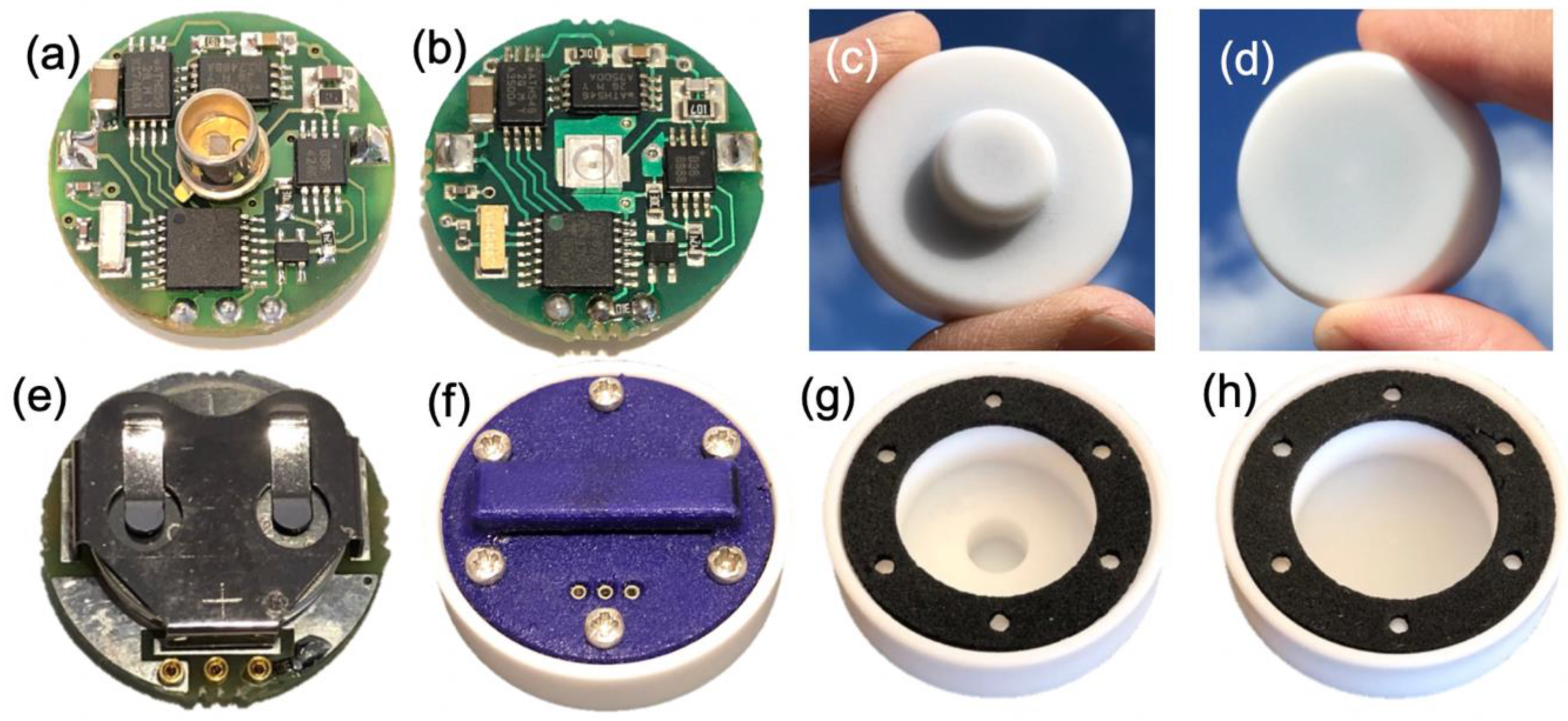
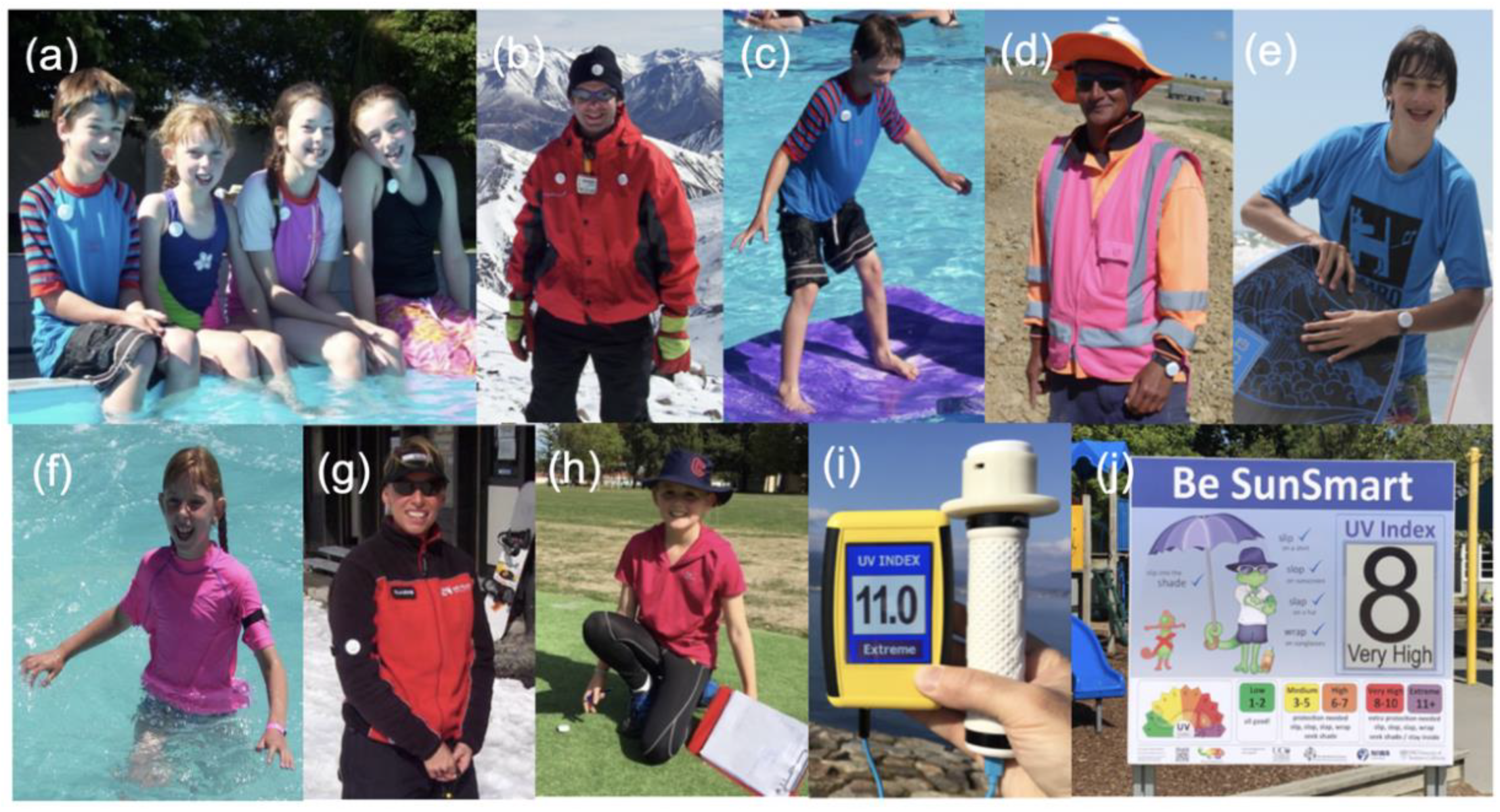
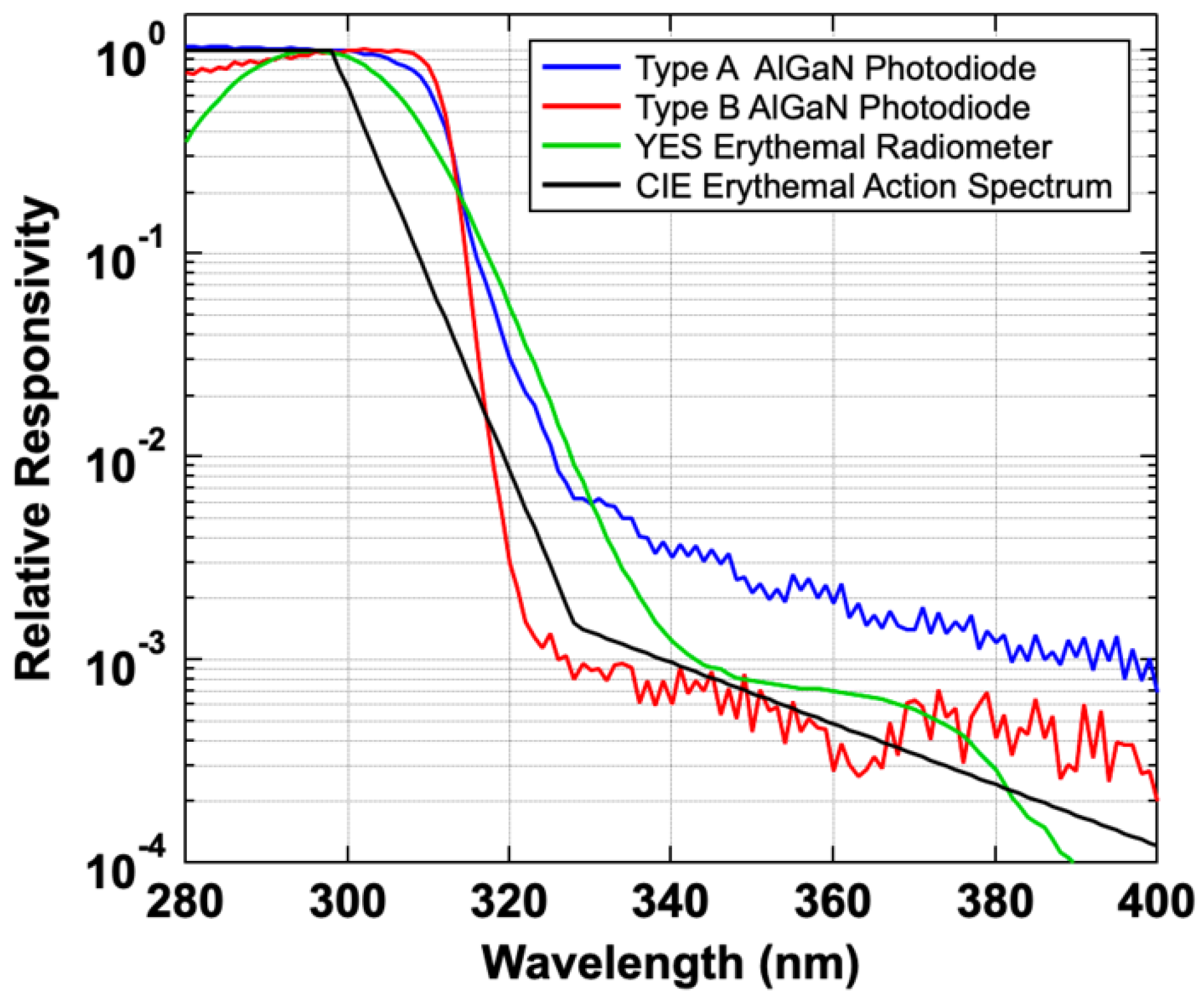

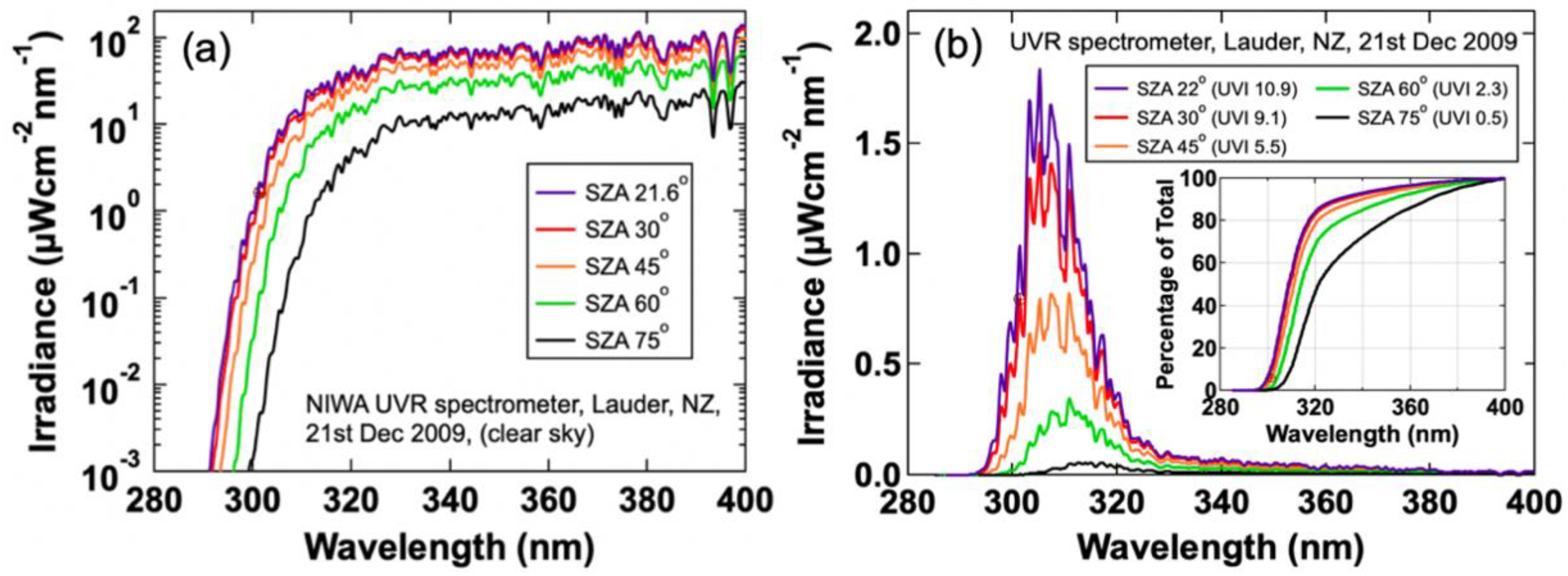
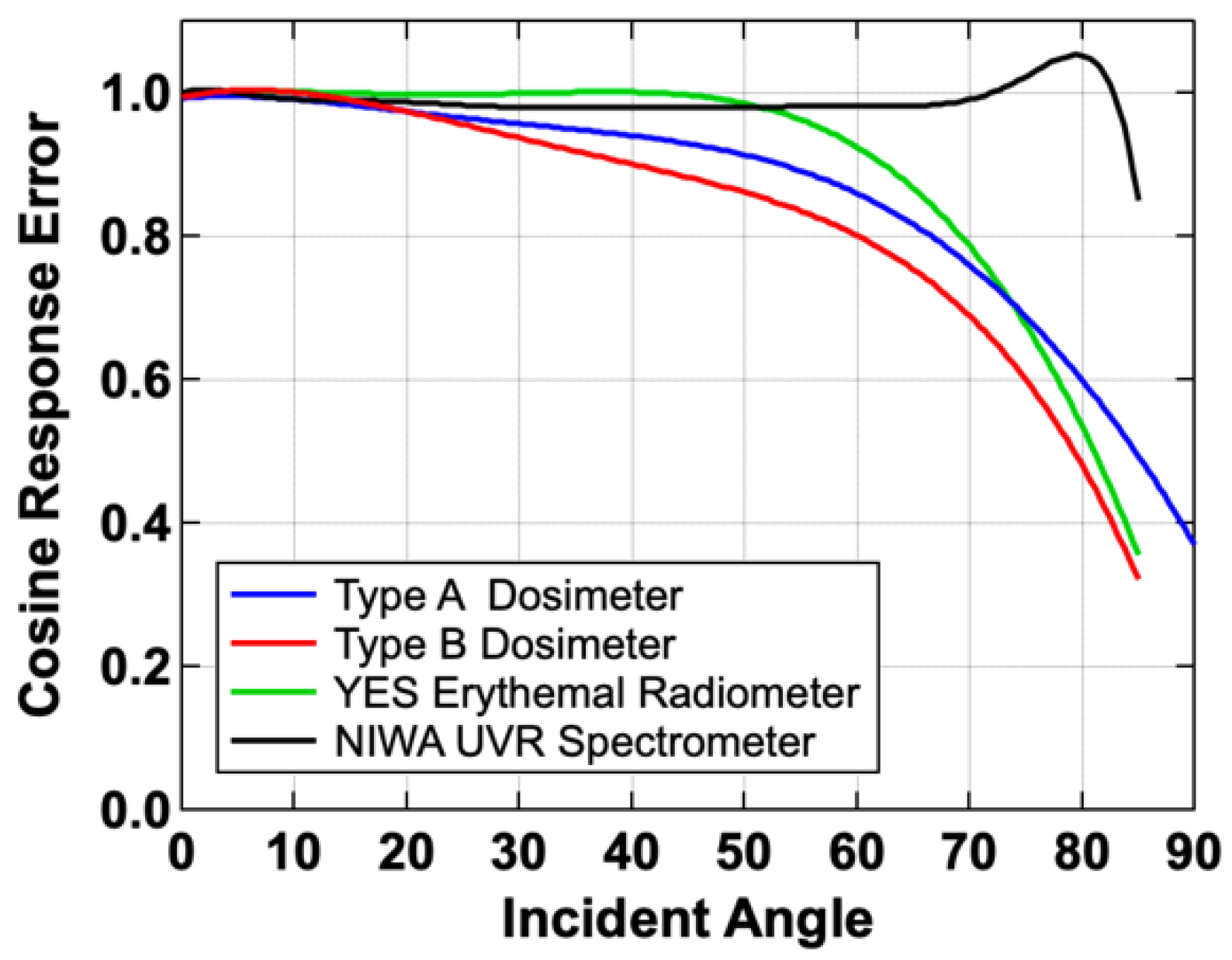
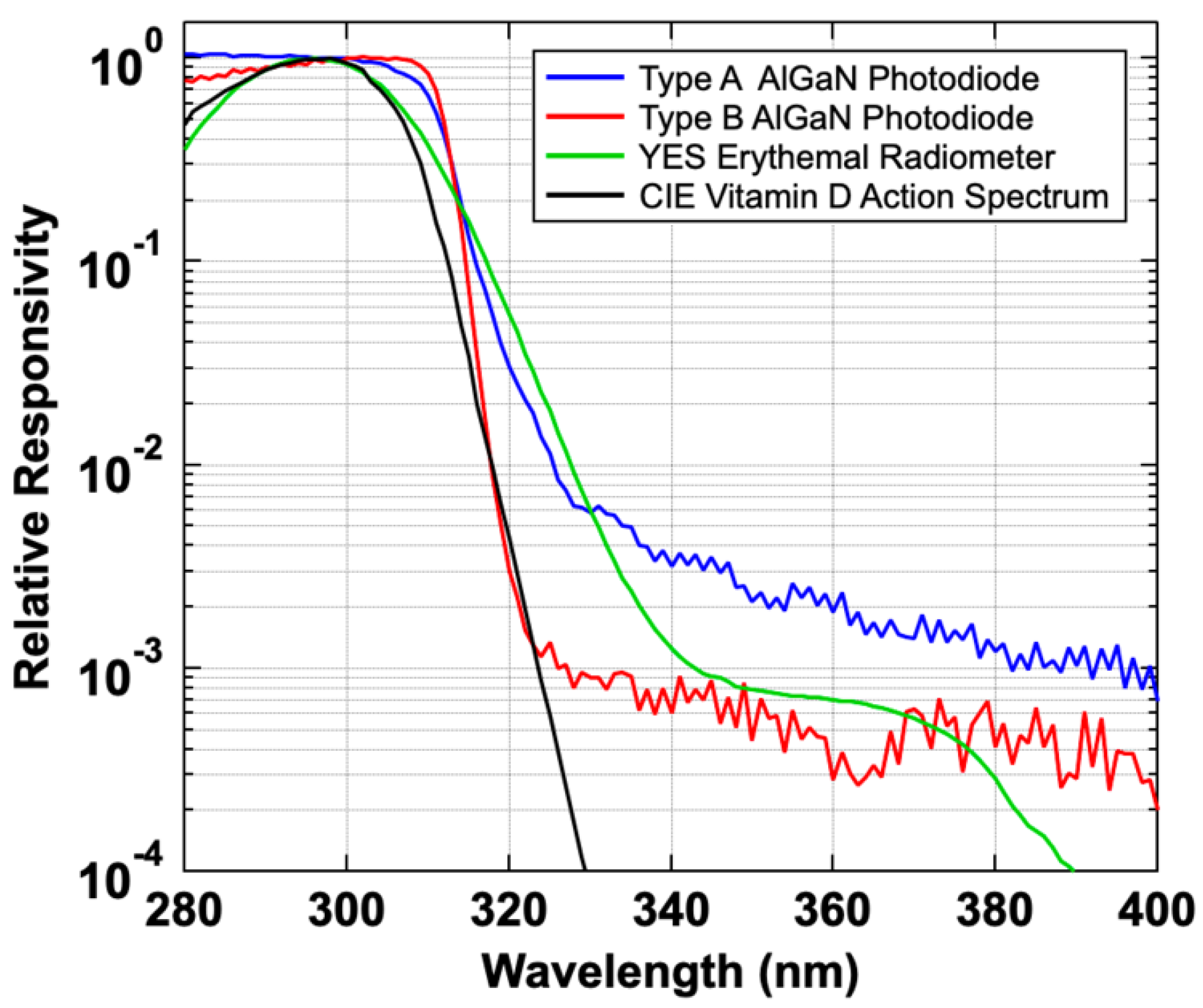
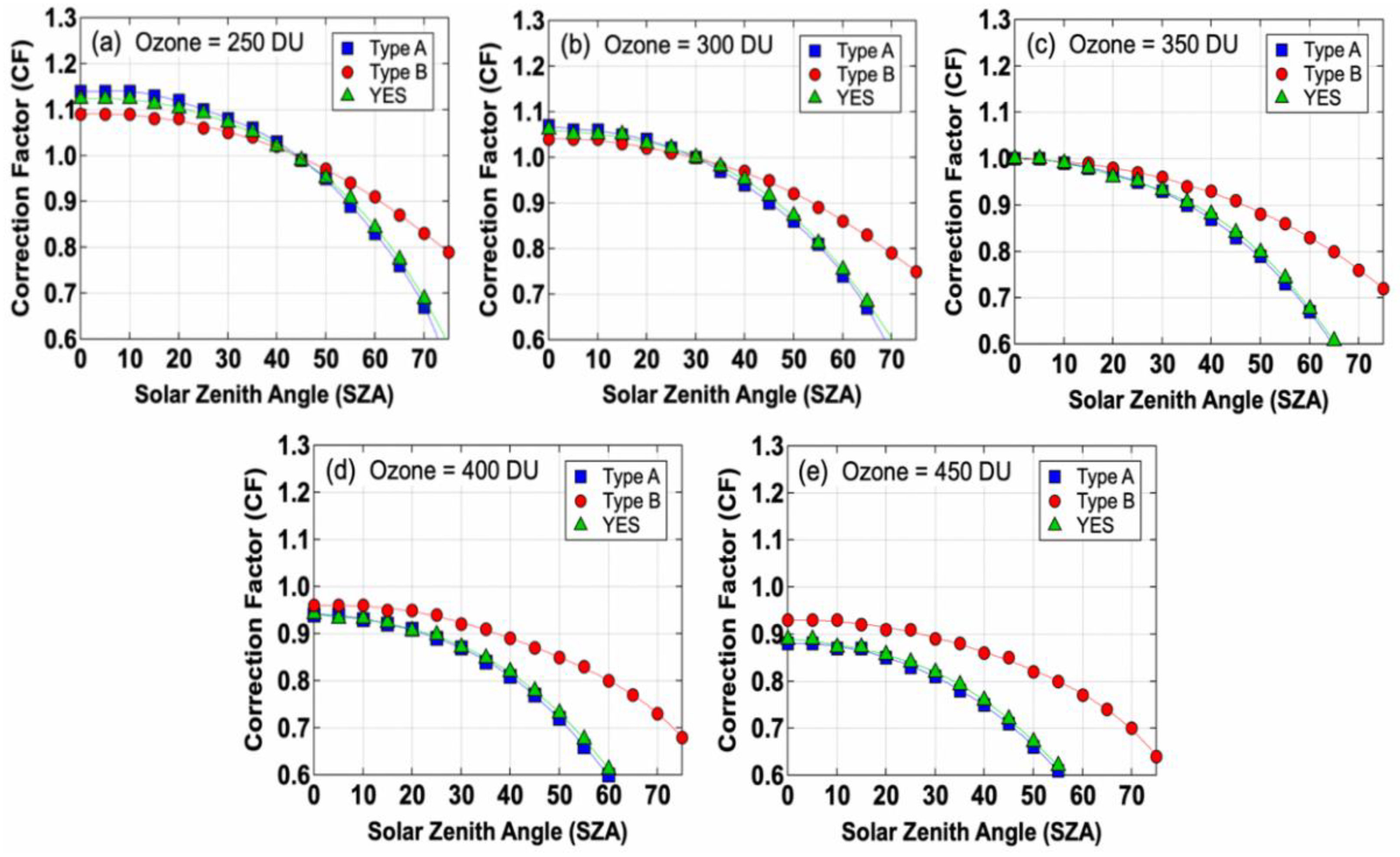
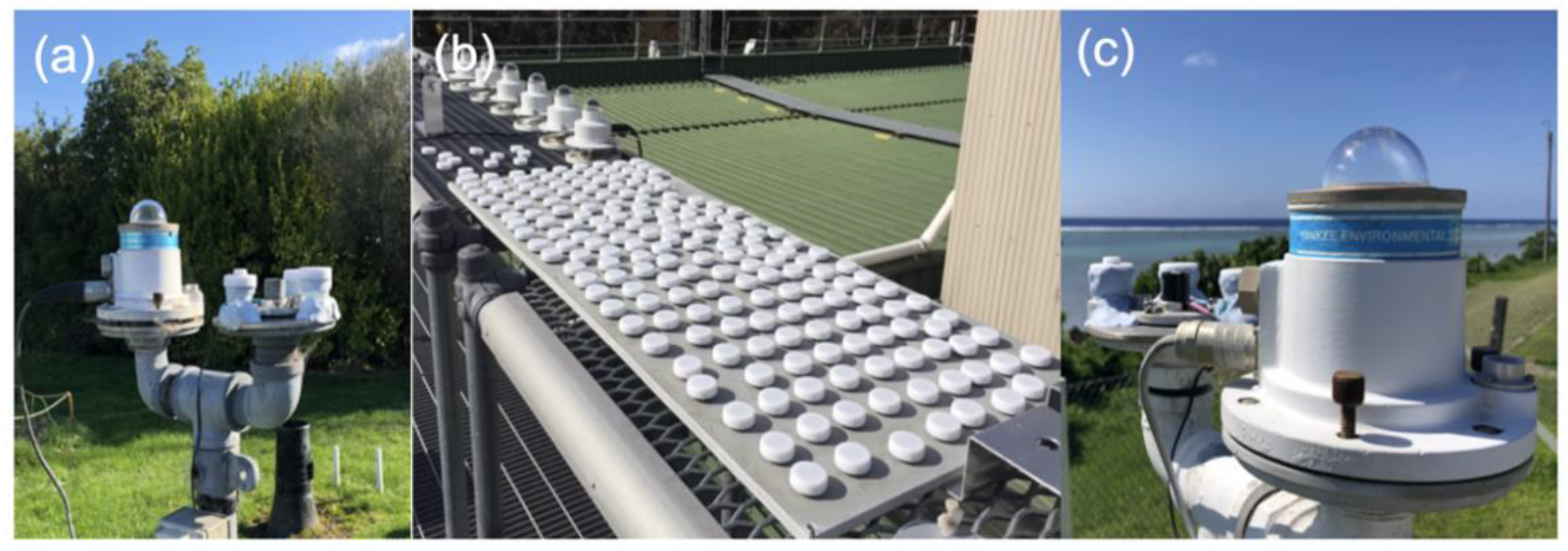
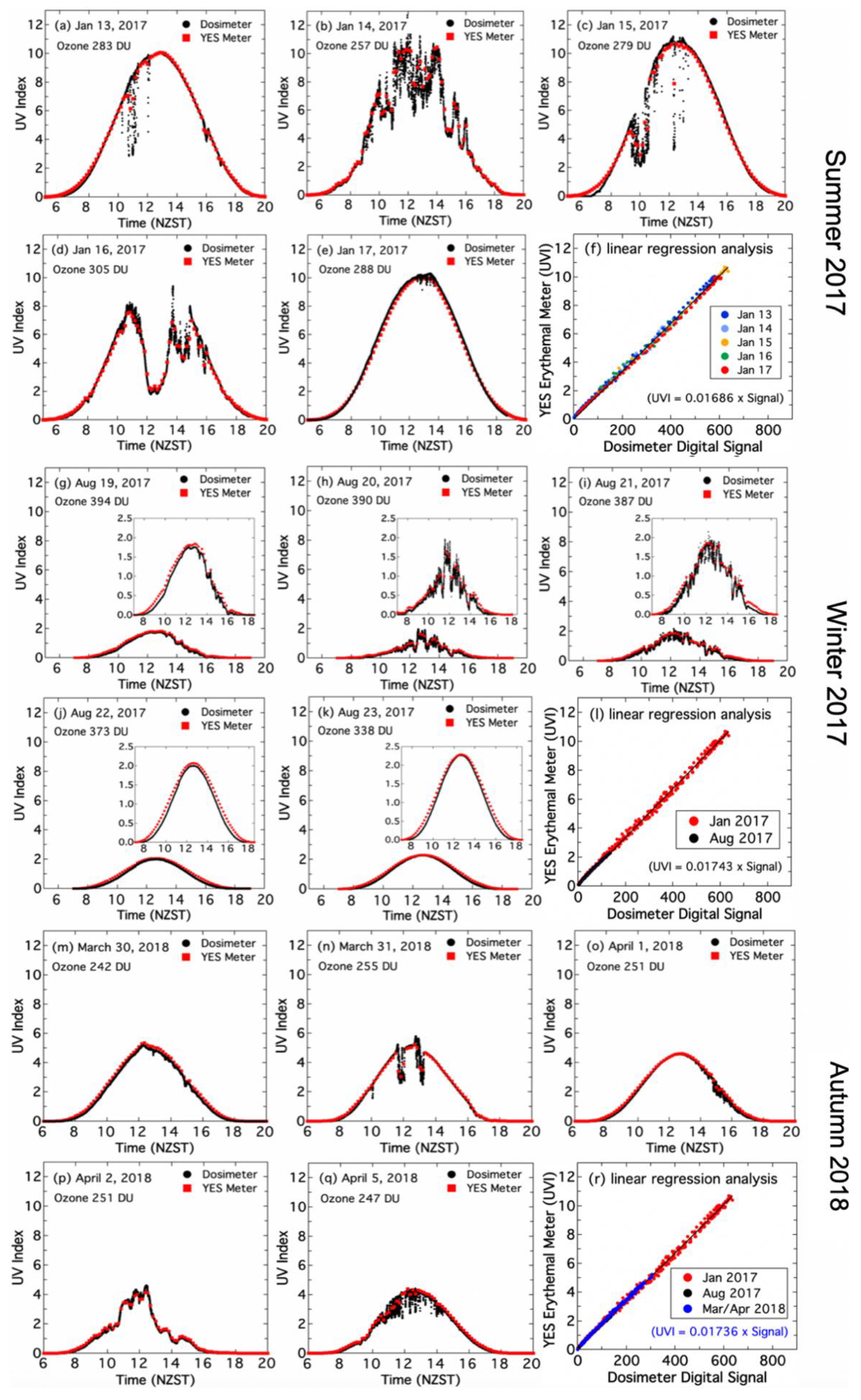




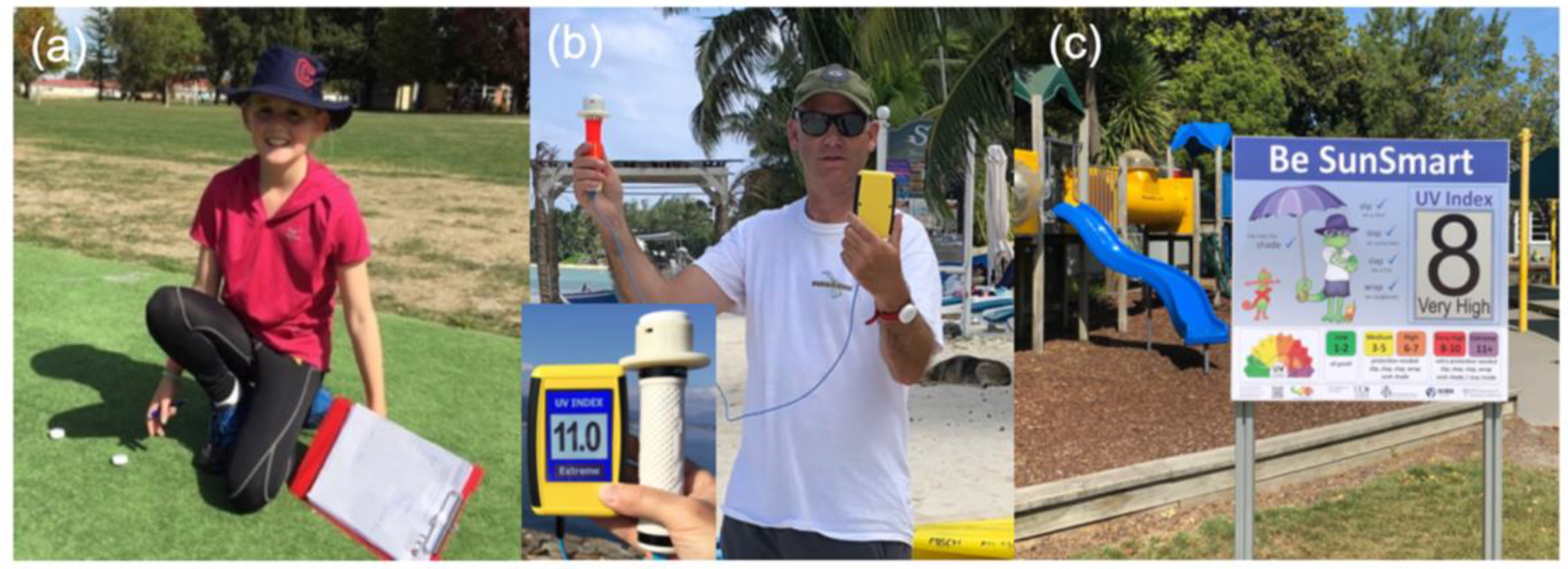
| Sampling Interval (t) (seconds) | Readings (per day) 1 | Memory Capacity (days) 1,2 | Battery Life (days) 1 |
|---|---|---|---|
| 2 | 21600 | 6 | 36 |
| 4 | 10800 | 12 | 76 |
| 8 | 5400 | 24 | 137 |
| 12 | 3600 | 36 | 186 |
| 20 | 2160 | 61 | 260 |
| 40 | 1080 | 121 | 372 |
| 60 | 720 | 182 | 434 |
| 120 | 360 | 364 | 520 |
© 2020 by the authors. Licensee MDPI, Basel, Switzerland. This article is an open access article distributed under the terms and conditions of the Creative Commons Attribution (CC BY) license (http://creativecommons.org/licenses/by/4.0/).
Share and Cite
Allen, M.W.; Swift, N.; Nield, K.M.; Liley, B.; McKenzie, R.L. Use of Electronic UV Dosimeters in Measuring Personal UV Exposures and Public Health Education. Atmosphere 2020, 11, 744. https://doi.org/10.3390/atmos11070744
Allen MW, Swift N, Nield KM, Liley B, McKenzie RL. Use of Electronic UV Dosimeters in Measuring Personal UV Exposures and Public Health Education. Atmosphere. 2020; 11(7):744. https://doi.org/10.3390/atmos11070744
Chicago/Turabian StyleAllen, Martin W., Neil Swift, Kathryn M. Nield, Ben Liley, and Richard L. McKenzie. 2020. "Use of Electronic UV Dosimeters in Measuring Personal UV Exposures and Public Health Education" Atmosphere 11, no. 7: 744. https://doi.org/10.3390/atmos11070744
APA StyleAllen, M. W., Swift, N., Nield, K. M., Liley, B., & McKenzie, R. L. (2020). Use of Electronic UV Dosimeters in Measuring Personal UV Exposures and Public Health Education. Atmosphere, 11(7), 744. https://doi.org/10.3390/atmos11070744







